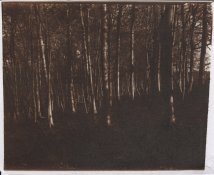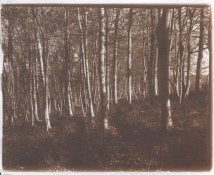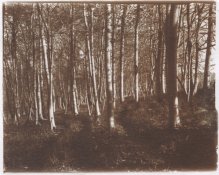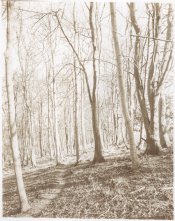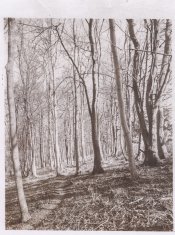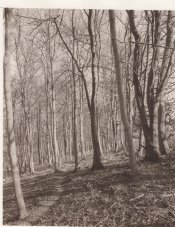I usually put this sort of thing over at f295, but with that site going away soon, I thought I'd put a copy here too, where it can safely wait in case someone in the future is interested in this process. I'm not aware of anyone making these today, although the formula is on the brown print page at unblinking eye.
It might suffer a little from something that Blansky and others have noticed: sometimes people focus so much on the process that they forget to try to make a good picture! It's not the greatest pinhole tree, but I guess it's not terrible I actually chose this negative because I thought it would be difficult to print and I wanted it to reveal weaknesses in the process. I think it displayed the strengths instead!
I actually chose this negative because I thought it would be difficult to print and I wanted it to reveal weaknesses in the process. I think it displayed the strengths instead!

Namias' Sepiaprint par Ned, on ipernity
Rodolfo Namias' Sepiaprint
Pinhole paper negative, heritage oak at Finley Community Center in Santa Rosa, California
Left: still wet after fixing. According to Namias, the browns would get much darker if allowed to dry.
Right: final dry print after toning.
I read Namias' 1901 article describing an iron-silver process. It is somewhat like a so-called “Van Dyke Brown” print, but uses citric acid instead of tartaric acid. It is not one of the historic processes that has remained popular today. I can't find much record of its use, except in “sepia paper” used for copying technical drawings, similar to the way blueprints were used. Since I had all the needed supplies, I thought I'd try it.
I followed the directions in the article and made this print from a pinhole paper negative. Everything went just as Namias described, which in itself is a refreshing change from usual. Usually there are all sorts of things that can go wrong, but it made a nice print on the first try.
This must be the simplest and easiest printing process I've ever tried:
then wash.
Everything was done as simply as possible. I already had eyedropper bottles of
that I use to make salt prints. I made another eyedropper bottle with:
A drop ratio of 1:2:2 is close to the formula in Namias' article. I used:
This was much more than enough to coat a piece of 5x7 inch paper.
I used Canson Universal Sketch paper, which does have an alkaline buffer, but it worked just fine.
You can see the highlights are perfectly clear white with no fogging and no hint of yellow.
Brushed on with an inexpensive foam brush, no brush marks or uneven areas are visible.
Exposed it for ½ hour under BLB compact fluorescent lamps, it did not look done, so exposed for ½ hour more. Then it was time for dinner so I just turned the lamps off.
After dinner, it was interesting to see the image intensify in the wash, just as Namias described. Then it intensified again and changed color in the hypo. I used a heaping ½ teaspoon of sodium thiosulfate in about 60ml water to fix the image.
Namias recommended gold thiocyanate toner after fixing, so I mixed a weak toning solution of:
Toned in this for about 10 minutes, until it did not seem to be changing much.
Washed for an hour then dried on a sheet of glass overnight.
I think it is remarkable how there is detail in the deepest shadows ( on the tree and in the background on the right ) and in the most extreme highlights ( bulletin boards on the building in the background ). Also the sky is perfectly paper white. On the negative, the building is blown out and the shadows on the tree and leaves in the near foreground are deep; it's impressive to see tone and detail in both places. There's also a sense of light in the shadow areas. I was tempted to look again and make sure I printed the right negative.
This is a fun and interesting process, and particularly simple. Next time I will let one dry down without toning and see what it looks like. With the right negative, it might make a nice print!
It might suffer a little from something that Blansky and others have noticed: sometimes people focus so much on the process that they forget to try to make a good picture! It's not the greatest pinhole tree, but I guess it's not terrible
 I actually chose this negative because I thought it would be difficult to print and I wanted it to reveal weaknesses in the process. I think it displayed the strengths instead!
I actually chose this negative because I thought it would be difficult to print and I wanted it to reveal weaknesses in the process. I think it displayed the strengths instead!
Namias' Sepiaprint par Ned, on ipernity
Rodolfo Namias' Sepiaprint
Pinhole paper negative, heritage oak at Finley Community Center in Santa Rosa, California
Left: still wet after fixing. According to Namias, the browns would get much darker if allowed to dry.
Right: final dry print after toning.
I read Namias' 1901 article describing an iron-silver process. It is somewhat like a so-called “Van Dyke Brown” print, but uses citric acid instead of tartaric acid. It is not one of the historic processes that has remained popular today. I can't find much record of its use, except in “sepia paper” used for copying technical drawings, similar to the way blueprints were used. Since I had all the needed supplies, I thought I'd try it.
I followed the directions in the article and made this print from a pinhole paper negative. Everything went just as Namias described, which in itself is a refreshing change from usual. Usually there are all sorts of things that can go wrong, but it made a nice print on the first try.
This must be the simplest and easiest printing process I've ever tried:
- brush on the senistizer, let dry
- expose the print
- wash for 2- 3 minutes
- fix for 2-3 minutes
then wash.
Everything was done as simply as possible. I already had eyedropper bottles of
24% silver nitrate
12% citiric acid
12% citiric acid
that I use to make salt prints. I made another eyedropper bottle with:
25% ammonium ferric citrate
A drop ratio of 1:2:2 is close to the formula in Namias' article. I used:
6 drops silver nitrate + 12 drops citric acid + 12 drops ammonium ferric citrate
This was much more than enough to coat a piece of 5x7 inch paper.
I used Canson Universal Sketch paper, which does have an alkaline buffer, but it worked just fine.
You can see the highlights are perfectly clear white with no fogging and no hint of yellow.
Brushed on with an inexpensive foam brush, no brush marks or uneven areas are visible.
Exposed it for ½ hour under BLB compact fluorescent lamps, it did not look done, so exposed for ½ hour more. Then it was time for dinner so I just turned the lamps off.
After dinner, it was interesting to see the image intensify in the wash, just as Namias described. Then it intensified again and changed color in the hypo. I used a heaping ½ teaspoon of sodium thiosulfate in about 60ml water to fix the image.
Namias recommended gold thiocyanate toner after fixing, so I mixed a weak toning solution of:
2.5 ml 0.2% gold chloride + 2.5ml 2% ammonium thiocyante in about 70ml distilled water.
Toned in this for about 10 minutes, until it did not seem to be changing much.
Washed for an hour then dried on a sheet of glass overnight.
I think it is remarkable how there is detail in the deepest shadows ( on the tree and in the background on the right ) and in the most extreme highlights ( bulletin boards on the building in the background ). Also the sky is perfectly paper white. On the negative, the building is blown out and the shadows on the tree and leaves in the near foreground are deep; it's impressive to see tone and detail in both places. There's also a sense of light in the shadow areas. I was tempted to look again and make sure I printed the right negative.
This is a fun and interesting process, and particularly simple. Next time I will let one dry down without toning and see what it looks like. With the right negative, it might make a nice print!
Last edited:


 (flipped it after scanning)
(flipped it after scanning)